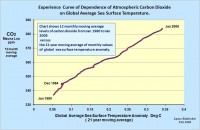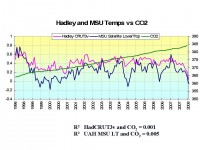Posted by Paul Biggs on the Jennifer Marohasy Blog
According to Lance Endersbee:
The CO2 levels in the atmosphere are damped by the oceans. The oceans are a huge source and sink for volatile gases. The surface area of the oceans is vast in relation to the depth of the oceans and the atmosphere. Thus we are dealing with a surface phenomenon.

See larger graph here.
The above chart is an actual experience curve relating actual CO2 levels with actual global average sea surface temperatures. It is not a time scale, just the simple relation between two physical parameters. The line is made up of the succession of actual monthly plotted points. If we have regard to the possible errors of measurement of CO2 and SST, it is remarkably consistent. The clear relationship is what would be expected from solubility data. It is only evident in the temperature data from satellite sources. The 21 year moving average covers the double solar cycle, including the change in solar polarity. It also covers El Nino and La Nina events. It also recognizes the longer response time of the oceans. This chart proves that human emissions of CO2 cannot accumulate in the atmosphere. They are scavenged as they occur. We can use the chart to predict the decreased levels of CO2 that will result from cooling.
From Joe D’Aleo:
Below is the monthly Hadley land and ocean and UAH MSU lower tropospheric temperatures over the last decade plotted with the CO2. Note the temperatures have not warmed, something even IPCC’s head Dr. Rajendra Pachauri took note of (paraphrasing him - as for the plateauing of temperatures in recent years, we have to see if there are natural factors offsetting greenhouse gases). Note the correlation with CO2 has vanished the last decade for both data sets.

See larger graph here.
Aside from the brief bounce coming out of the moderate/strong La Nina of 1999, there has been no increase despite the steady climb of CO2. If we were nearing that ‘tipping point’ Hansen and Gore love to talk about, surely, a decade is not too short a period to expect some thermal response to CO2 increases. See Jennifer’s Blog here. For more on the oceans’ role compared to CO2 see this earlier blog (updated).




